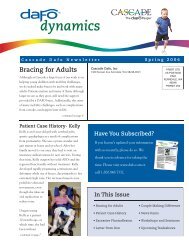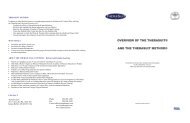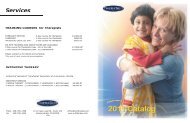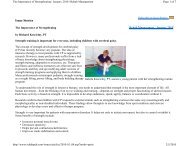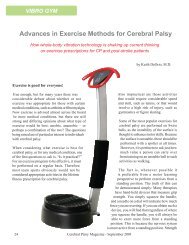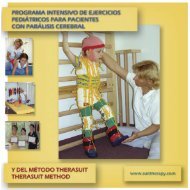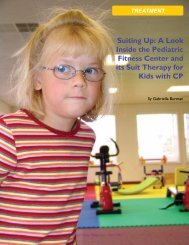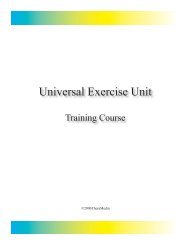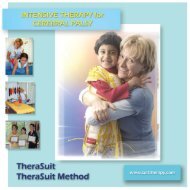Download - TheraSuit Method Intensive Suit Therapy for Cerebral ...
Download - TheraSuit Method Intensive Suit Therapy for Cerebral ...
Download - TheraSuit Method Intensive Suit Therapy for Cerebral ...
Create successful ePaper yourself
Turn your PDF publications into a flip-book with our unique Google optimized e-Paper software.
HBOT and <strong>Suit</strong> <strong>Therapy</strong><br />
improvements in both physical function and cognitive ability.<br />
So, significant brain recovery is still possible later in life. The<br />
reality that most of us have or will experience is that the<br />
physicians that treat those with cerebral palsy and other brain<br />
injuries have had no exposure to Hyperbaric Medicine during<br />
their careers, so they do not prescribe HBOT.<br />
How can HBOT improve the <strong>Cerebral</strong> Palsy condition<br />
and other brain conditions?<br />
When cells in the brain die, either from trauma or lack of<br />
oxygen, blood plasma leaks out into the surrounding brain<br />
tissue causing swelling and reducing blood flow. These<br />
otherwise normal cells go dormant because they can’t<br />
function without the appropriate amount of oxygen. HBOT<br />
dramatically increases the oxygen carried in the blood<br />
plasma and other bodily fluids (which is normally quite<br />
low) by up to 2,000% making oxygen available to heal<br />
damaged capillary walls, preventing plasma leakage and<br />
reducing swelling. As the swelling decreases, normal blood<br />
flow can be restored to the dormant tissue<br />
(neovascularization) and these cells then have the potential<br />
to go back “on-line” and function normally.<br />
It is at this point, you would expect to see improvement in<br />
the areas where there are deficits. Un<strong>for</strong>tunately, there<br />
are no factors (age, condition, length of time from injury,<br />
etc.) that absolutely predict or guarantee the degree of<br />
improvement. However, what we have experienced at our<br />
facility in treating neurological conditions (infants through<br />
seniors) with HBOT is that 67% received such significant<br />
benefit, that they chose to return <strong>for</strong> additional treatments…<br />
% of Patients who Returned to HHI <strong>for</strong> Additional HBOT<br />
<strong>Cerebral</strong> Palsy 74%<br />
Multiple Sclerosis 71%<br />
PDD / Autism 63%<br />
Stroke 58%<br />
Our findings are similar or greater than some of the more<br />
<strong>for</strong>mal studies done on HBOT and its effect on <strong>Cerebral</strong><br />
Palsy individuals. The following study was presented in<br />
November of 2000.<br />
The Cornell Study (condensed)<br />
Dr Maurine Packard Division of Child Development<br />
and Pediatric Neurology - Study Design<br />
This study was designed as a randomized, delayed entry<br />
trial of the effects of HBOT on children ages 1 to 5 years<br />
with moderate to severe CP. Enrollment criteria were 1)<br />
age between 1 and 5 years; 2) moderate to severe CP; 3)<br />
no evidence of brain mal<strong>for</strong>mation; 4) developmental<br />
delay of at least 33% in one area; 5) no active seizures<br />
<strong>for</strong> the previous 6 months. The protocol consisted of 40<br />
one-hour sessions of HBOT at 1.5 ATA. The sessions were<br />
scheduled twice a day, five days a week <strong>for</strong> four weeks.<br />
We did not design a double blind study, in which some<br />
children would receive placebo treatments, <strong>for</strong> several<br />
reasons. First, this was a pilot study to see if there was<br />
any evidence of benefit <strong>for</strong> these children. Second we<br />
purposefully enrolled children of various ages and<br />
disability levels to evaluate the efficacy of HBOT in a<br />
range of affected children. Third, as time in the chamber<br />
is very expensive, we wanted as much in<strong>for</strong>mation about<br />
treatment effects as possible. Finally, it seemed unethical<br />
to have parents devote so much time and energy to a<br />
potentially ineffective treatment.<br />
Demographics<br />
The study population included 26 children, ages 15<br />
months to 5 years, with cerebral palsy secondary to<br />
prenatal insults, premature birth, birth asphyxia, and<br />
post-natal hemorrhage. The subjects were enrolled at a<br />
rate of 4 per month and matched roughly to age and<br />
severity. The average age at enrollment was 30 months.<br />
The average motor age was 7.5 months; the average<br />
cognitive age and language age were both l2 months.<br />
Nine had cortical visual impairments.<br />
Assessment<br />
Intake assessments included a neuro-developmental<br />
assessment, Bayley II (cognitive assessment), Preschool<br />
Language Scale (language assessment), the Peabody<br />
Motor Scales (an assessment of gross and fine motor<br />
skills), Pediatric Evaluation of Disabilities Inventory<br />
(PEDI), a parental report of specific skill in mobility, selfcare,<br />
and social interactions. Assessments were<br />
conducted at four time points: T1 - at enrollment; T2 -<br />
<strong>Cerebral</strong> Palsy Magazine-December 2004 49




